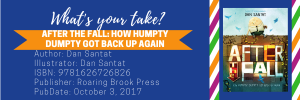by Seemi Aziz, University of Arizona, Tucson, AZ, and Melissa Wilson,Leeds Trinity University, Leeds, West Yorkshire, UK
Happy New (Gregorian) Year! To welcome in 2021, we, Seemi and Melissa, are going to explore the concept of mindfulness through critical readings of powerful children’s picture books. We have come to understand that visual and written narratives work simultaneously to add to the understanding and comprehension of children and adults in the present, increasingly visual, world. As the worldwide pandemic of Coronavirus rages on, we all need resources to cope with constant disruptions and uncertainty. Mindfulness is a resource that may benefit both adults and children and one that can be explored through picture books.
“Mindfulness is awareness that arises through paying attention, on purpose, in the present moment, non-judgmentally… it’s about knowing what is on your mind.” – Jon Kabat-Zinn
The above quote nicely defines mindfulness for our purposes. Rooted in ancient religious practices, mindfulness came to the United States in the 1970s as a secular way to help people through the work of Kabat-Zinn. In the ensuing half century, the concept has become part of western culture.
Throughout this month we will discuss specific picture books to explore mindfulness with children. The specific texts are: After the Fall: How Humpty Dumpty got back up again by Dan Santat, Charlotte and the Quiet Place by Deborah Sosin, and The Three Questions by Jon Muth. As we unravel the narratives, we will add other titles that reinforce the concept of mindfulness.
This story begins after the well-known narrative of Humpty Dumpty where he falls and breaks, and all the King’s horses and men cannot put him back together again. Santat gives it a different twist as he goes forward and spins a tale about how Humpty Dumpty does get back together and overcomes his fear of heights by focusing on passion for bird watching.
SEEMI: As I read the story, I enjoyed the twists and turns of a story that I had grown up with. I particularly appreciated the manner in which Humpty Dumpty overcomes his fear and manages to get back up on the wall to pursue his passion. The ending was particularly impressive as HD transforms from an egg to a bird that breaks free of the shell and becomes a bird just like the ones he loved watching. It seemed kind of logical when I thought of it. His short but precisely written narrative is for adults as well as children and is reinforced by the visual imagery that speaks to a younger audience so much more. I also appreciated when HD tries and tries again to make that perfect plane that will fly and take him over the wall and into the sky only to lose again to an accident of it flying over the wall into oblivion.
I also appreciated Santat’s artwork and his personal story that initiated the twist of the narrative that he wove. I was in the hall when he spoke about his wife’s struggle with depression that made it necessary for him to put pen/brush to paper. Santat’s brilliance comes with narratives that are out of the box. His book The Adventures of Beekle: The Unimaginary Friend gave him the coveted Caldecott medal.
I can imagine how children can and will respond to the story. This speaks to our theme of mindfulness by bringing a well-loved narrative alive again by giving it a positive ending. Children who have gone through trauma and negative life events can take so much out of it as can any child who wants and needs to think empathetically. This narrative brings to life the necessity of positive thinking and motivation.
I would recommend the three Sophie books by Molly Bang that have the same thematic strain of children overcoming their everyday stress by various mindful techniques such as taking time out for controlling anger and frustration and hurt. When Sophie Gets Angry—Really, Really Angry… (1999), When Sophie Thinks She Can’t…(2018), and When Sophie’s Feelings are Really, Really Hurt (2015), all by Blue Sky Press.
MELISSA: Like you, Seemi, I enjoyed a different ending of the famous nursery rhyme! Santat takes a tragic ending and transforms it into a sad beginning; HD is put back together on the outside, but inside, he is still broken. The story is told in first person narrative, which allows the reader to empathize with HD’s struggles of sadness and fear. His struggle can be a stand in for so many struggles we all, younger and older people, continue to have during a worldwide pandemic. We have all learned, to quote HD, “accidents can happen”. And like our protagonist many of us are afraid we will not be able to do the things that we love again.
The text has possibilities to explore mindfulness with children. We are privy to HD’s mind as he shares his feelings and actions. We are there as he tries to construct the perfect bird.
We watch him try and fail and then succeed. We have a chance, as Kabat-Zinn defines mindfulness above, to “pay attention… non-judgmentally…in the present moment”. And as we live through HD’s struggles, we can connect to our own. HD’s fear of heights can stand in for all our own fears of how to make a life during a pandemic during a time that is so full of the unknown. As HD climbs the ladder to get back to the wall where it all began, the reader if climbing too, wondering what will be on the other side.
Title: After the Fall: How Humpty Dumpty Got Back Up Again
Author: Dan Santat
ISBN: 9781626726826
Publisher: Roaring Brook Press
PubDate: October 3, 2017
Throughout January 2021, Seemi Aziz and Melissa Wilson look at picturebooks that explore mindfulness to children. Check back each Wednesday to follow the conversation!
- Themes: After the Fall, Dan Santat, Melissa Wilson, Seemi Aziz
- Descriptors: Books & Resources, My Take/Your Take



I agree with everything said about this. It’s funny, because when HD began to crack after his difficult ascent, I didn’t see feathers but rather leaves and thought maybe he would just join a whirlwind and be a part of everything. Then when I saw the wings on the next page it all clicked and it made me realize how transferrable this story was to my own emotional struggles. Amazing counter-narrative to our whitebread and bland influences.
Lol I thought he was eaten by a bird at the end!! I thought it was some dark twist: try to conquer your fears, probably still get eaten by the world. I immediately closed the book and read another to my girls at bedtime to try and save them from the nightmares of birds. They probably understood what you all did all along! I’m so glad I read these, I was so confused!